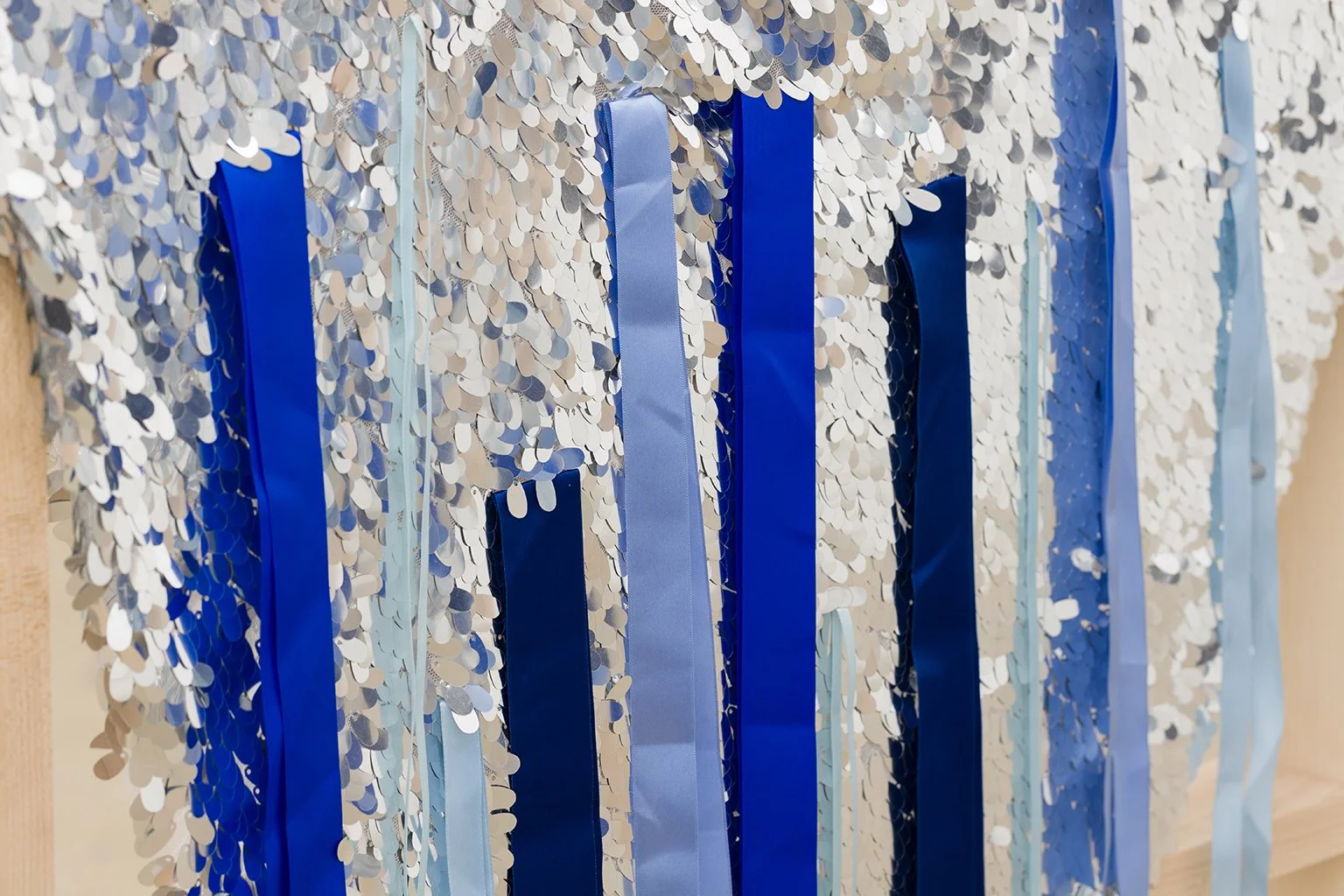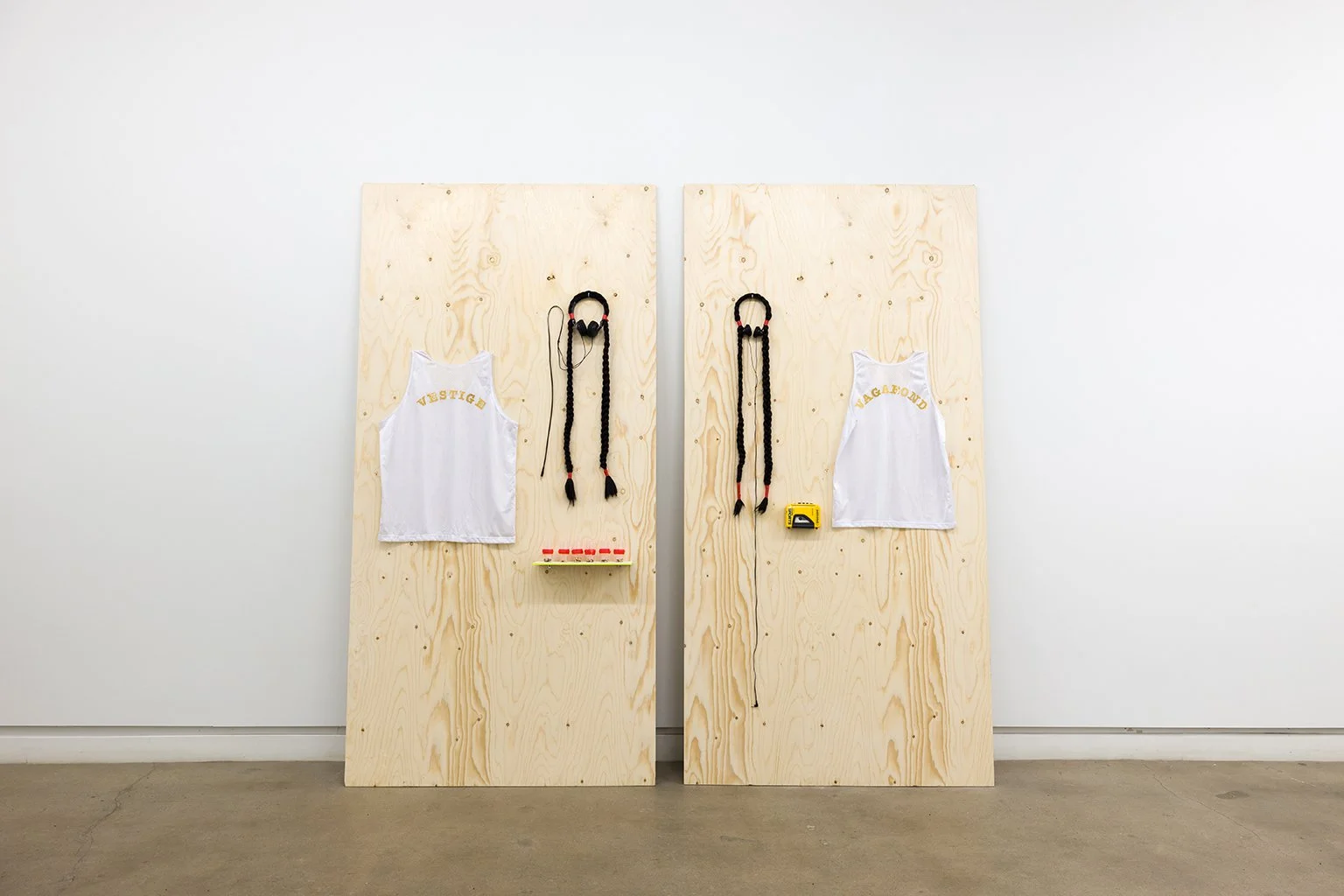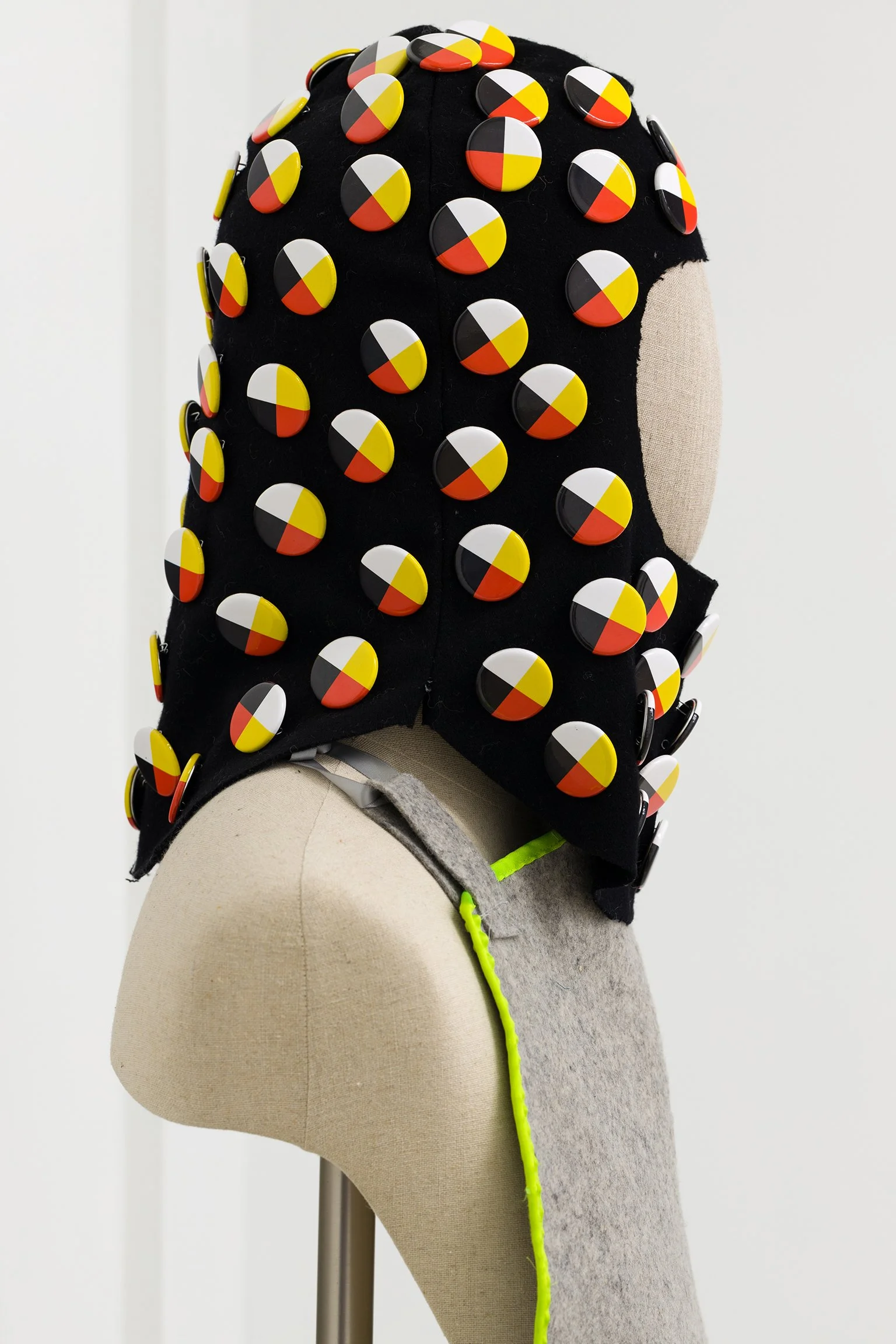Manidoowegin - Spirit Skin: A Conversation with Maria Hupfield | Alaina Perez
June 1, 2022
Maria Hupfield, Manidoowegin, detail, 2022 | image: Mike Patten
On March 17, 2022, I attended a talk by Maria Hupfield at Diagonale in Montréal for her exhibition Manidoowegin - Spirit Skin: Memory and Form. Before I made my way to the show I had been thinking about how making is an act of becoming. To be a maker, one is making worlds, one is becoming a creator. Perhaps this is how we communicate and learn with our ancestors. They whisper through the hand and tell us that we are the creators. This becoming is an activation. It’s an activation of subjectivity, a rupture of selfhood.
Throughout her practice Maria speaks to how objects contain memory. Sherry Farrell Racette describes the Anishinaabemowin word manidoowegin as meaning spirit skin. In English, it can be translated as a fine woolen cloth. Manidoowegin has its own memory; it knows where it has been, and who has touched it. Manidoowegin will remember the body it envelops until it is worn again.
The gallery at Diagonale was intimate, with objects arranged to favour neither wall nor floor. When Maria entered, she invited the objects to join her as she thoughtfully introduced each of us to the pieces she had created. Maria embraced the pieces as she recalled the memories that she and these objects share together. It was so welcoming to be invited into this space and to witness a reconnection between good friends.
Standing structures wrapped with ribbon stood in the middle of the room, proud and upright. Maria showed us that these pieces had wheels and together they skated around the room. The gallery space was like a closet: a coat hanger made of felt hung on the wall next to a friendly apron. Two sports pinnies laid side by side, one marked with vestige and the other vagabond, and these twins each had a pair of braided headphones and a mixtape, perhaps produced for one another. A black hood covered in unity pins played its percussive music as Maria picked it up and placed it on her head. Everything in the gallery was set off by a black banner that stretched along the southwest corner of the room, telling us: “Land, and and, and and and, and and and and…”
—Alaina Perez
Alaina Perez
I am moved by how, as an artist, you’re able to sustain both a material practice as well as a performance practice, and how none of the objects shown at Diagonale are still-objects.
Maria Hupfield
I guess I don’t really see the two as separate, first of all. So that probably would have something to do with it. It is a funny sort of thing, but when I make something I’m not necessarily done with it. I want to keep using it, and I imagine that it has more work to do. As I’m making it, I move it around, turning it over, and maybe that also gives me ideas. The way I make things is connected closely to myself, to my body. So one of the things I haven’t done so much is post-studio production, or sending things out to be fabricated. I am the one that needs to do it. I don’t often work with patterns—which would make more sense—but part of figuring something out happens as I make it.
Maria Hupfield, Manidoowegin, installation, Diagonale, 2022 | image: Mike Patten
I remember making a large-format camera out of felt. It was a replica, and that, for me, was a material exercise. I am always thinking about the material and working through it. I am realizing in the pandemic that it also has a lot to do with my own “self-regulation.” There is a fulfilment that I get through it, and also a kind of thinking that happens as I’m making work and having busy hands.
AP
A person at your talk asked a question about how you feel when you’re creating work, and, if the works are about difficult subject matter that Indigenous peoples have to live with and carry, how do you make sure the act of creation is not a defeating process?
MH
The thought for me when I create something is, why am I creating it? It’s just something that I wanna do, it’s something that I feel I need to do. And, then, with every performance—y’know, this is helpful—I feel like it’s my last performance, like “I’m done after this.” I don’t mean, “It’s so taxing.” I mean that at that moment everything is coming together and that’s what I’m working towards, and I’m not thinking, “I'm gonna do another and another and another.” Sometimes that is the case, if I’m doing three performances over a month, right? Sometimes I’ll return to it and work with it more in a new way. But, then, when I’m done, I think, “I’m done!” Until another moment comes up, and then I think of a new combination or something else to try, and that fills me with hope. It makes me feel like things are possible.
Maria Hupfield, Manidoowegin, details, 2022 | image: Mike Patten
I haven’t necessarily talked with a lot of other performance artists about their processes and what motivates them. The other part of it, for me, is that I’ve been living in Brooklyn, so I’ve been working with and have encountered a lot of performance art by artists who aren’t necessarily Native. So it's been a very recent thing for me, since returning home, to have an occasion to work with another Native artist. That’s something I’m thinking about. Especially through my work at the university as an Indigenous academic. Because I’ve always seen myself, first and foremost, as an artist. So I’m starting to think about when you have the title of “Indigenous” and how it comes with a lot of work and responsibility, work to community, responsibility to community. When you’re an artist that may be there too, but in a different kind of way. And I think being an artist first gave me a lot of freedom and flexibility.
I’ll be curious to see in a few years how I feel about things and where I land and what I’m up to. In the past I’ve been very specific about how I present myself in certain spaces, whereas now I’m more about being fully myself in all of my complexity—I’m just going to do what I’m going to do anyway and I’m not necessarily going to leave a part of me at the door. Part of the thing is that I’ve just had to get over the fact that I don’t know if people are ready for the kind of work that I want to make. And I feel like, even if they won’t understand it, I just have to go for it for myself and be like, “If they can’t—so what? They’ll catch up at some point.”
AP
I think that’s a really important aspect of how Indigenous people are able to orient their creative practices to fulfill their needs and how we’re able to work through things materially. It goes far and beyond the space in question. It extends to our relations. I was thinking about how your practice is a constant relational expansion. When you spoke of revisiting the works, your husband mentioned how you yourself are changing each time, as well, and I was moved by that. So, when you are making your works, who are you speaking to and how does that feel?
MH
The making is a very sort of private, intimate, fully self-realized moment for me. In my studio it really is fully on my terms—it’s my turf and I bring the things I want together. Perhaps that’s why it always feels like such a violation, how if you work on something and then you see someone else pick it up and you’re like, “Hey, that’s part of me!!” And the initial feeling is always something like, “Hey! Say my name when you do that!” Or ”Hey! Don’t erase me!”
Artists often influence one another and you can see how you start to impact and influence other people. I think that it’s always good to be aware that you’re writing history and you’re making history as you’re doing it. That’s something I’m mindful of around methodology and ethical practice, and I think a lot about these things and my own well-being and wellness.
Maria Hupfield, Manidoowegin, installation, Diagonale, 2022 | image: Mike Patten
In terms of what happens outside of the studio, that really changes. I really think of it as a conversation I’m having. There’s a conversation with place and knowing who else is there. So there’s a lot of “Who is going to see the show?” One of the strengths of live performance is you can respond to all of that.
I remember there was a performance by Skeena Reece at Emily Carr University, and she dressed up as Emily Carr, she had a Dempsey Bob image, and she started to paint on it in the gallery as part of her performance, and when she looked up Dempsey Bob was standing right there! I mean, she could’ve invited him, who knows? Or maybe he just came because he wanted to see her. I don’t know what put the events in motion, but I feel like life is like that, where you can’t make this stuff up because it’s way more interesting how things actually happen.
In my performances, I am making space to connect with people, to allow new visualities or conversations to happen that might not otherwise. Whether that be through collaboration: someone does something as you’re doing something else and that makes meaning in a way you couldn’t anticipate. But also in terms of this idea of “meaning-making,” and how we can put this out in the world and then other people who are there will have other experiences with it. It’s a gesture of trust, perhaps?
AP
One thing that stood out to me was the Unity Hood (2017). You mentioned how for much of your professional career you have not wanted to incorporate certain symbols into your practice, and how more recently your thoughts about that are beginning to change. It made me think of this sort of recuperation of symbols, like a détournement almost—giving them what they want but on your own terms.
MH
I did some other iterations of a balaclava, or, as I’m calling it, a hood. I liked the idea of having something to cover your head with. I have a piece at the Art Gallery of Ontario that has coins on it. I know a lot about the Medicine Wheel, as I’ve taught it and used it and created programs around it. I remembered how they would always give out a little unity pin and you’d wear it, you’d pin it. There are a lot of symbols that are very much embedded with meaning, and there’s so much to them. Like the Medicine Wheel, there’s so much going on, and what I try to avoid is flattening that or making it a simplistic rendering.
Maria Hupfield, Manidoowegin, detail, 2022 | image: Mike Patten
It was a very straightforward thing to use—to have bought. I remember seeing that you could buy a whole bag of the pins, and I was like “I’M BUYING ALL OF THEM!” And then when I was looking at them. I loved that there were so many. And there was something different happening when you had so many. And then I had made a Jingle Hood, where the jingle spiraled to the top of your head, and you could wear it. And I was like, “Well, I wanna do that, but with the Unity Pins.”
I am using something, whether it’s a Jingle or a Medicine Wheel, in a way that you’re not used to seeing it, and you’re seeing it in relation to my body. So those two things inform each other and suddenly there is this new insight into the Medicine Wheel. When the Jingle isn’t on a Jingle Dress, I am still aware of the dress, and what I make reminds me of all the teachings of a Jingle Dress. But I’m also aware that someone who doesn’t know about a Jingle Dress might miss all of that. And depending what I’m doing they may also get it on another level, right? Like when I made Jingle Spiral (2015) and my sister Deanne wore it. I learned so much about Pow Wow dancing by seeing her wear it. Her movements allowed me to become aware of how much I know but also how much I don’t know.
What makes my job hard is when people do not value Native knowledge and they don’t bother to look deeper. I suppose I want people to do that, but as an artist it still holds up, right? I kind of feel like I’m doing double-work all the time, because it’s not empty. It’s not “just a pretty face,” right? It’s got substance and getting people to go there with me has been a challenge. But I’ve seen a lot that I never thought would be possible happening. So I think I’ll just keep doing my stuff.
AP
During the pandemic, all of my senses have crossed over and touch, especially, is changed for what it means to me and my body and how I experience the world.
Maria Hupfield, Manidoowegin, installation, Diagonale, 2022 | image: Mike Patten
MH
Yeah. This exhibition was my first time showing all that stuff together, in that way, to bring forth this idea that you’re talking about the body and to figure out display strategies. Looking at it now, it seems obvious. I’m becoming very deliberate and mindful of how important contextualizing my work is. Curatorial decisions can influence and impact my work, and questions like: how to talk for myself and take control over that? Or how do I need people to talk about the work? There are people who will go off and do all kinds of crazy things with it that are not what I intend.
AP
That was the first time I’ve been in a gallery since the pandemic. The space was configured in a wonderful way, especially with the moving pieces in the middle of the room. I was so happy to be there and to hear you talk about movement and how oppressive the stillness can be within a gallery space.
MH
I think that’s a good point. If you see the exhibit, there might be one idea of the work, but after we go through it together and you see me in it, there may be this other dimension that opens up, and I love that. Not that it’s about me, but it’s about any time there is life or a person around work and it comes back to really valuing. When you think of an archive or how much people love the stuff in the museum, they love that stuff, but yet they don’t really like the people. Right? How can that be? There’s so much there that you don’t understand, but if you know the people, it comes alive.
AP
When you said, “I don’t like archives,” I was thinking, “Me neither!” Peter Morin, wrote a piece called On Being A Museum and Embodied Tahltan Epistemologies. He talks about how his entering the Royal British Columbia Museum activates everything because he is a part of these objects, and they are a part of him, and how this exchange of relation can’t be contained within that space. There are forms of knowledge that are a part of these things that aren’t seen or kept when they go into a place like the museum or archive.
MH
I think there’s an argument around the question, “Can you decolonize a museum?” Well, no, because the whole structure of it is forged in a certain way. You can’t decolonize it unless you tear it down, right?
Maria Hupfield, Manidoowegin, detail, 2022 | image: Mike Patten
AP
Yeah.
MH
Dr. Jennifer Wemingwans wrote a book called Digital Bundle, and what she does very well in that book is make a distinction between being someone who has traditional knowledge, or knowledge of traditional ways of being and doing, versus reading about something—knowing about something, right? She does a very good job of breaking down the different forms of language around Indigenous knowledge and how we can protect and promote. What does that mean in an art space? If I was, for example, to show in an Indigenous-run gallery that was Anishinaabe, that would be very different than showing at the Tate Modern, right?
AP
Absolutely.
MH
It's not to say one is exclusive of the other or that it's one or the other, it's just saying that there’s multiple ways that you can be in the world. I had very strong opinions early in my career, where I was like, “Well, if I wanna make a Jingle Dress, I’ll wear that and dance in a Pow Wow.” I’m not going to make that and sell it in a commercial gallery, because for me that’s not the place of that culture. I will use jingles, but in this other way—and that has been about navigating and understanding those spaces: “Will it be appreciated? Will it be respected? Will it be acknowledged? Will it be honoured? Is that the space for it? What’s my responsibility? Can I take proper care of it in these spaces?” Sometimes you can, and sometimes you can’t. It's not to say you can’t bring a Jingle Dress into a gallery, but, for myself, the distinctions I make help me sort through some of those questions. In the same way as when I said there was a time where I didn’t put anything under vitrines because I felt that it would smother them, right? Now I ask, how do I use a vitrine so it doesn’t smother? Well, I’ll put holes! So it can breathe, so I don’t feel like I’m smothering it.
Maria Hupfield is the City of Toronto Inaugural ArtworxTO Legacy Artist in Residence (2022) and a Mellon Distinguished Fellow at the Center for the Imagination in the Borderlands, Arizona State University (2020–22). Her touring solo exhibitions, The One Who Keeps On Giving, organized by The Power Plant (2017–18), and Nine Years Towards the Sun, by the Heard Museum (2019–20), included live performances. More venues include: The New York Museum of Art and Design, BRIC House Gallery, Bronx Museum, Boston Museum of Fine Arts, Site Santa Fe, New York Smithsonian Museum of the American Indian, Art Gallery of Ontario, the National Gallery of Canada, Montréal Museum of Contemporary Art, the NOMAM in Zurich, the Montréal Museum of Fine Arts, Galerie de L’UQAM, Galerie Hugues Charbonneau, and Patel Brown Toronto. Hupfield was awarded the Hnatyshyn Mid-Career Award for Outstanding Achievement in Canada (2018). She is co-owner of Native Art Department International with her husband artist Jason Lujan and is a member of the Anishinaabek People belonging to Wasauksing First Nation in Ontario. She an Assistant Professor in Indigenous Performance and Media Art and a Canadian Research Chair in Transdisciplinary Indigenous Arts at the University of Toronto Mississauga.
Alaina Perez is an artist and writer currently completing a Master’s of Arts in the Individualized Program at Concordia University in Tiohti:áke/Montréal, Canada. She is a member of the Tahltan Nation and was born and raised in Vancouver, British Columbia.








